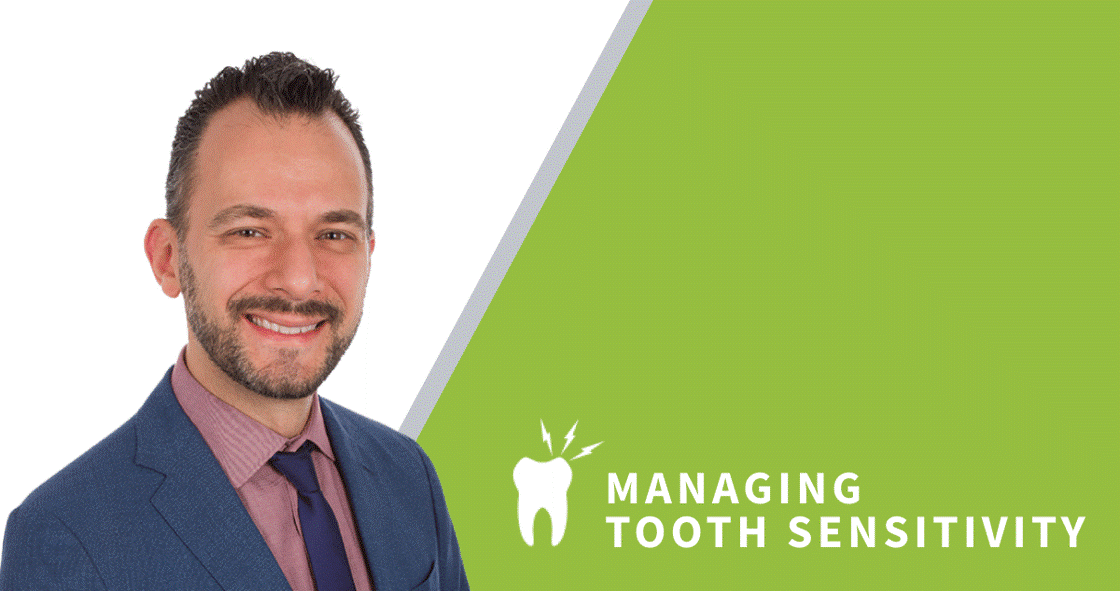By Dr. Rafael Beolchi
Tooth sensitivity is one of the most common complaints among dental patients and it is usually associated with the exposition of dentinal tubules and/or vulnerable enamel.1, 2 The main mechanism of pain is because of the fluid movement inside the dentin tubules, which may result in pulpal nerve stimulation. It is important to remember that not all cases of exposed dentin will necessarily mean the presence of exposed dentin tubules, and that’s because of areas where sclerotic dentin might be present.
The consumption of acid-containing foods and beverages (such as acidic drinks and fruits), can also increase the risk for sensitivity. Bulimia and acid reflux can also increase and/or at least participate in enamel erosion and should always be on the dentist’s radar for a proper diagnostic.
Regarding dental whitening, the occurrence of a mild temporary sensitivity is something that sometimes can be associated with with this kind of treatment. However, it is also usually gentle and transient in most cases.3
It is important to note that this temporary sensitivity does not usually have a permanent impact, and as mentioned before, besides areas of exposed dentinal tubules (usually present in areas of gingival recession), sensitivity can also occur with poorly fitted or aging restorations, in areas where non carious cervical lesions are present, or with non-detected caries, especially in interproximal regions.
In relation to the kind of bleaching agent, a comparative systematic review of tray-delivered carbamide peroxide gels versus hydrogen peroxide products (for at-home bleaching) found that both methods had relatively equal levels of tooth sensitivity and gingival irritation.4
It has also been reported that transient mild to moderate tooth sensitivity can occur in up to two-thirds of users during early stages of a bleaching treatment5, therefore something that can be considered a normal occurrence.
It is fundamental to know that this kind of tooth sensitivity can and should be treated, and there are many ways for a professional to do it. Treatments range from sealants to diode lasers, including potassium nitrate gels and fluoride.
Chemical neural agents such as Potassium Nitrate are an easy, fast, and cost-effective method, usually the first option for most cases. Ultradent Products offers UltraEZ™ as such a method, a gel that can be used on the patient’s custom trays, or that can also be used through its exclusive pre-filled trays. Potassium nitrate has also the advantage of providing faster results compared to other methods.
Another desensitizing method is the use of Fluoride varnishes, such as Enamelast™. The mode of action is different from Nitrate Potassium in the sense that Fluoride is expected to temporarily block the entrance of exposed dentinal tubules.
As mentioned before, another additional method is the use of Diode Lasers, which can be used to treat the pulp tissue through photobiomodulation, PBM.
Below there’s a guide that might be helpful in treating patients with dentin hypersensitivity:
Pre-Whitening Sensitivity Treatment
- The Patient has history of sensitivity or tests positive to touch or air exam.
- Suggest dental check-up to check for decay two weeks prior to whitening. Create custom trays as needed.
- The Patient brushes with Opalescence Whitening Toothpaste Sensitivity Relief prior to and during whitening treatment.
- Apply an Enamelast fluoride varnish treatment. Whitening can begin the following day.
- The Trays are evaluated for fit, gingival irritation, and ease of removal.
- The Patient begins whitening with low-concentration whitening gel.
- The Patient wears a tray with UltraEZ desensitizing gel for 15–60 minutes.
During Whitening Treatment
- Provide reduced concentration whitening product if possible.
- The Patient reduces wear time.
- The Patient skips a day or more of whitening.
- The Patient brushes with Opalescence Whitening Toothpaste Sensitivity Relief.
- The Patient uses UltraEZ desensitizing gel for 15–60 minutes before and/or after whitening treatment.
- If gingival irritation occurs, review technique for filling and inserting tray. If necessary, the patient may use OTC oral pain relief products as directed.
- If the patient is unable to manage whitening sensitivity, discontinue whitening treatment.
Finally, it is a known fact that the use of UltraEZ desensitizing agent for 30 minutes prior to whitening helps decrease tooth sensitivity6. The use of an active 3% potassium nitrate and 0.11% fluoride desensitizing agent for 30 minutes prior to whitening decreased tooth sensitivity when compared with a placebo in a population at risk for tooth sensitivity.
It can be concluded that the desensitizing agents are effective in relieving dentin hypersensitivity. The short-term treatment of dentin hypersensitivity with UltraEZ showed a statistically significant reduction in the sensation of pain when compared with the placebo7.
References
1. SoaresPV, Grippo JO. Lesões cervicais não cariosas e hipersensibilidade dentinária cervical: etiologia, diagnóstico e tratamento.1a.ed. SãoPaulo: Quintessence; 2017.
2. SoaresPV, Machado A C and cols., Hipersensibilidade Dentinária: Guia Clínico. Ed. Santos Pub, IK Publishing, SãoPaulo, 2019.
3. Eachempati P, Kumbargere Nagraj S, Kiran Kumar Krishanappa S, Gupta P, Yaylali IE. Home-based chemically-induced whitening (bleaching) of teeth in adults. Cochrane Database Syst Rev 2018;12(12):Cd006202.
4. Luque-Martinez I, Reis A, Schroeder M, et al. Comparison of efficacy of tray-delivered carbamide and hydrogen peroxide for at-home bleaching: A systematic review and meta-analysis. Clin Oral Investig 2016;20(7):1419-33.
5. Hasson H, Ismail AI, Neiva G. Home-based chemically-induced whitening of teeth in adults. Cochrane Database Syst Rev 2006(4):CD006202.
6. Leonard RH Jr, Smith LR, Garland GE, Caplan DJ. Desensitizing agent efficacy during whitening in an at- risk population. J Esthet Restor Dent. 2004;16(1):49- 56.
7. Ozen T, Orhan K, Avsever H, Tunca YM, Ulker AE, Akyol M. Dentin hypersensitivity: a randomized clinical comparison of three different agents in a short-term treatment period. Oper Dent. 2009;34(4):392-398.








